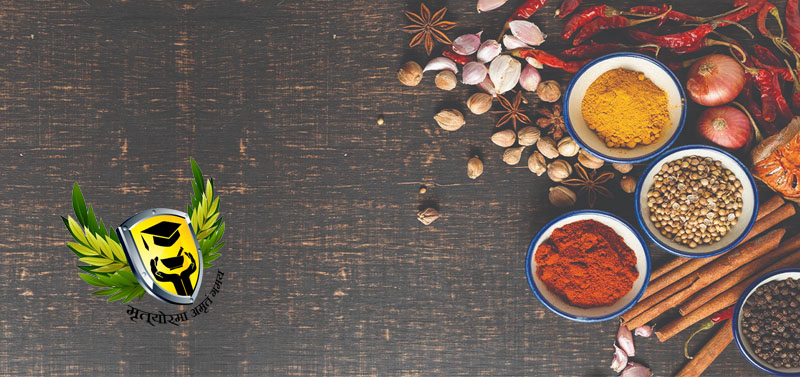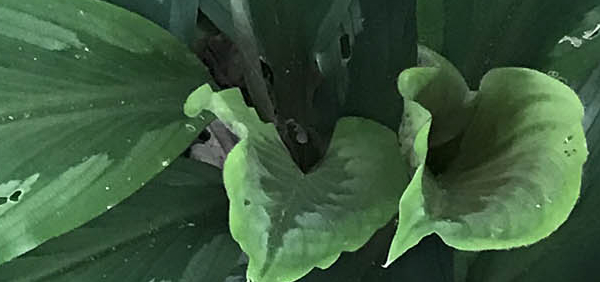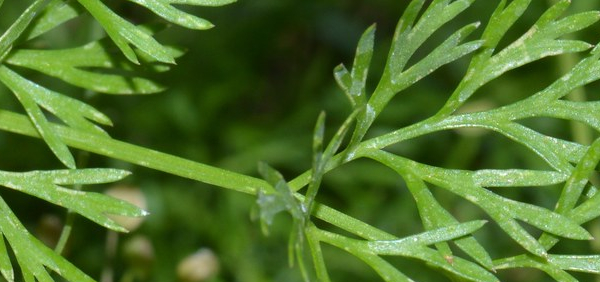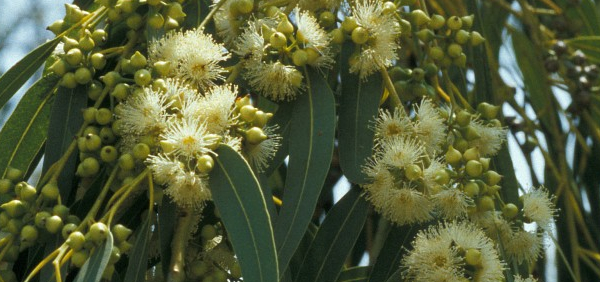shami :
 Parmotrema perlatum, commonly known as black stone flower or kalpasi, is a species of lichen used as spice in India. The species occurs throughout the temperateNorthern and Southern Hemispheres. Typically used in meat dishes like nahari (Paaya), Bombay biryani, Goat meat stews, it is also used in vegetarian dishes. It is one of the ingredients in East Indian Bottle Masala, used for cooking Meats, fish and vegetables.
Parmotrema perlatum, commonly known as black stone flower or kalpasi, is a species of lichen used as spice in India. The species occurs throughout the temperateNorthern and Southern Hemispheres. Typically used in meat dishes like nahari (Paaya), Bombay biryani, Goat meat stews, it is also used in vegetarian dishes. It is one of the ingredients in East Indian Bottle Masala, used for cooking Meats, fish and vegetables.HISTORICAL AND MYTHOLOGICAL REVIEW:
Two lichens are found in all Indian bazars, which are known as the greater and lesser "stone-flowers" in the vernaculars, and in Sanskrit as Sila-valkā or "rock-bark." Similar plants were known to the Greeks as βρυον and σφαγνος, and to the Romans as Muscus. Dioscorides (i., 22) notices of their medicinal properties, Pliny (xii., 61). The Arabs call them Ushnah, a name derived from the Persian, and Hazāz-el-sakhar "rock-scab." Leith says: "It is a thing that spreads on the trees", and it is sweet in odor, and white. " [Kāmūs.] In Persia these lichens are known as Ushnah and Dowālah. The author of the Makhzan el-Adwiya states that Ushnah grows upon the oak, cypress, and other trees; that which is whitest should be preferred; it should have an acceptable odor. He describes it as astringent, resolvent, and aperient, and says that the decoding is used as a tonic and alterative; when burnt, the smoke relieves headache, the powder is a good cephalic snuff. Externally the drug has emollient and astringent properties, and may be used in a bath or as a poultice, & c. The dry powder is applied to wounds and sores to promote granulation. Honigberger mentions the use of the drug at Lahore in disorders of the stomach, dyspepsia, vomiting, pain in the liver or womb, induration of the uterus, amenorrhea, calculi, and nocturnal spermatic discharges.Taxonomical Classification
Kingdom: Plantae - Plants
Division: Magnoliophyta - Flowering plants
Family: Parmeliaceae
Genus: Parmelia
Species: Parmelia perlata
Allied species:
grey Parmelia saxatilisVERNACULAR NAMES
Sanskrit: shami, shankuphala, keshahantri, shivaphala, ishani, shankar, lakshmi, mangalya, samiEnglish: stone flower
Hindi: Chadila
Urdu: Ushn
Telugu: Rati Puvu
Bengali: Shailaj
Marathi: Dagad PHool
Gujarathi: Chadilo
Tamil: Kalpasi
Kannada: Kallu huvu
Punjabi: Dagar da phool
Arabic: Hinna-i-Korisha, Rumman, Barri, Shaibah, Shaibat
Assamese: Bojhwar
French: Parmelia des murs
German: Wandschildflechte
Persian: Davala
Varities:
There are various species of lichens found variable shapes like tubular, upright, branching, and flat and leaf like.Definition
कालानुसार्य-वृद्धाश्मपुष्प-शीतशिवानि तु .10 ख.शैलेयं तालपर्णी तु दैत्या गन्धकुटी मुरा .11 क.
Synonyms
Synonyms in Ayurveda: shami, shankuphala, keshahantri, shivaphala, ishani, shankar, lakshmi, mangalya, samiShila dadru, Shilapushpa - Flowers are seen in between the rocks. this is the reason it is called stone flower in english.
कालानुसार्य - kālānusārya n .: blue-black The following
वृद्ध - vṛddha n .: Old, adult
अश्मपुष्प - aśmapuṣpa n .: stone flower
शीतशिव - śītśiva n .: the cold Merciful, frost-resistant
शैलेय - śaileya n .: Steinernes
Rasa: Kashaya Tikta
Guna: Laghu Snigdha
Veerya: Sheetha
Karma: Kaphahara Pittahara
The plant has astringent, bitter, acrid, cooling, anti-inflammatory and aphrodisiac properties.
Cultivation:
This herbal shrub is invasive and propagates fast. It is mainly grows near the damp areas.
It is widely found in India and other tropical parts of the world where grazing is casual and rains are heavy.
Phytochemistry:
Usnic acid is the key active component of Stone Flowers, which have antimicrobial and antifungal properties.PHARMACOLOGY:
important formulatons1. Sarvamayantaka ghrita
2. Mahabala tailam
Parts used for medicinal purpose
Whole plant, ,Dosage:
Plant—10-20 ml juice;50-100 ml decoction
powder - 1-3gm
Controversy:
kala has been accepted as synonym of several other drugs such as saileya, tagara, krishna sariva
though it is seetha veery drug, it is used along with ashta veerya drugs
Commercial value:
Parmelia perlata is reported to yield in a spectroscopic studies, a new
lanost-2-en type terpene named parmelanostene and a new labdane type
diterpenoid named permelabdone. It has also to be found to have
antebacterial potential against S.aureus and E.coli bacterial strains,
Tarique Abdullah et. al.,(2007).
Morphology:
Shaileya is a small plant growing in between the rocks, tree trunks and land through out the hilly regions of himalayas and north east indiaThe upper layer of leaves is green-black and whitish from inside. They also grow on trees gaining nutrition from rain running down the tree.
Geographical distribution:
It is usually a native of Indian subcontinent and found in northern India and Bengal.ECOLOGICAL ASPECT:
In general, Parmelia have a dark lower side with rhizines (rootlets) which attach the lichen to its substrate. The upper side may be several colours - grey, yellow, brown - and may have reproductive organs on it. These may be apothecia (spore producing bodies), isidia or soralia (both vegetative structures). In between these two layers is the medulla which contains the algalcomponent of the lichen.General Use:
- Lichens are used as fodder in Indian states and also have various culinary uses.
- It is thought to be a good pain reliever and used as a remedy to heal wounds.
- It also cures various skin disorders. It acts as anti-fungal, anti-biotic, expectorant, astringent and anti-viral.
Therapeutic Uses:
- Stone Flowers are an important ingredient in herbal compositions for the treatment of seminal weakness and male sexual debility.
- It is also administered in fungal infections in women, like vaginal candidiasis.
Systemic Use:
Stone flower is used as food and medicine. It contains no fat, carbohydrates and protein of 1-5% are present. It is eaten as soup and in salads. It is kapha and pitta suppressant. It is a good pain reliever and also promotes early healing of wounds due to its bitter taste. It helps in treating the skin related problem due to its cold potency. It acts as expectorant, antibiotic and astringent. It helps in avoiding the calculi and it helps in maintaining the normal body temperature. It is also used as anti-fungal and anti-viral agent. It is helpful in relieving from pain when applied on head. It also helps in itching and skin related problems. It helps in reducing any kind of inflammation in the body. It shows antibacterial activity and is fairly effective against Protozoans. Its decoction is given for laryngitis. It helps against boldness, period aches, worms and lice.Administration:
dried lichenPharmacological:
Leaf—carminative, antiinflammatory, astringent, spasmolytic, antidiarrhoeal, diuretic, antilithic. Root— anti-inflammatory. Used for rheumatic affections, piles, inflammations of the liver, spleen and chest.Clinical trials:
Antibacterial activity of Parmelia perlata
Author links open overlay panelAlwarVidyalakshmiKandaswamyKruthika
Research:
- Antidiabetic activity of Parmelia perlata in rats Vijai Lakshmi1*, Keerti Ameta, Ravi Sonkar, Mohammad Kaleem Ahmad, Santosh Kumar Agarwal, Abbas Ali Mahdi
Precautions:
naToxicity studies:
no adverse effect notedUse in other system of medicine:
Since the time of the first Chinese and Egyptian civilizations, these have been medicinally used in traditional system of medicines. The literary records of traditional knowledge of Indian medicinal plants demonstrated the lichen in Rigveda, a text where the first authentic record of ‘Aushadhi’ (medicine) has been described. Further the use of lichen in folklore as medicine has been mentioned in different pharmacopoeias of the worldCONCLUSION:
Parmelia Perlata (Huds.) Ach. belonging t o Parmeliaceae family is a lichen (a close symbiotic association between algae and fungi), commonly called ‘Stone Flower’ and ‘Charila’ in India. It i s widely distributed in hilly areas of Indian subcontinent. The lichen was fo und to contain several unique chemical constituents like usnic acid, lecaronic acid, salazinic acid, atronin etc and has been traditionally prescribed in bronchitis, excessive salivation, vomiting, toothache, boils, inflammations etc. It has also been indicated in seminal weakness, nocturnal emission, amenorrhoea, leucorrhoea, dyspepsia, calculi, blood and heart diseases, stomach disorders, enlarged spleen, bleeding piles, scabies, leprosy, general pains etc. It tones up the urinary tract and suppresses calculi formation. It has been used as traditional food by Rai and Limbu communit ies of East Nepal and also as light brown dye for wool as well as bio-indicator of air pollution due to heavy metals. Although it has already been substantiated for antimicrobial, antiurolithiatic, anticancer, antidiabetic potentials etc. yet not fully explored for therapeutic effects and thus remained pharmaceuticall y unexploited. It is probably due to difficulties in identification, bulk collection and lack of updated scientific reports on lichens.KEY WORDS: shami , Parmelia perlata (Huds.) Ach.
- » Classification and names of shami
- » Synonyms and definitions of shami
- » Drug Properties of shami
- » Chemical Constituents of shami
- » Standardization of shami
- » Parts used and Dosage of shami
- » Morphology and Histology of shami
- » Distribution and Conservation of shami
- » Cultivation of shami
- » shami in the market
- » Medicinal Uses of shami
- » Researches and clinical trails of shami
- » shami in other sytems of medicine
- » Ayurvedic formulations with shami
- » Images of shami












